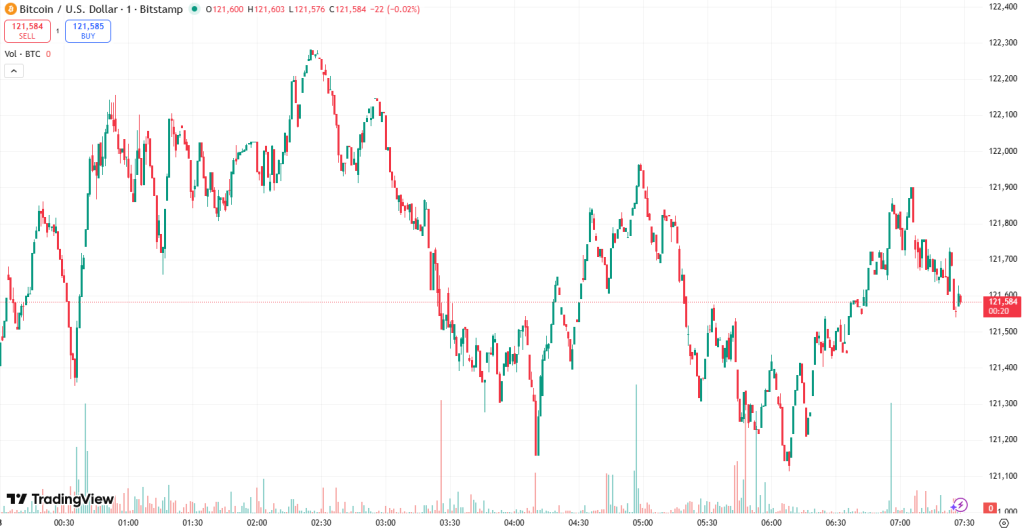The cryptocurrency market is experiencing a stutter today, with the total market cap dipping by 2.2%, now resting at approximately $4.26 trillion. Concerned investors are watching closely, as 90 out of the top 100 cryptocurrencies have seen price declines in the last 24 hours. However, amid the slumping prices, trading volume has surged, hitting an impressive $240 billion—far surpassing recent trends. What’s behind this market shift, and what should investors consider moving forward?
Why This Matters: The current downturn in crypto prices impacts not just investors but the overall sentiment within the market. As Bitcoin (BTC) and Ethereum (ETH)—the two largest cryptocurrencies—see significant fluctuations, they continue to serve as the barometers for market health and investor confidence. With Bitcoin recently slipping 1.8% to $121,788 and Ethereum down 4.7% to $4,455, the question on everyone’s mind is: are these corrections a normal part of the market cycle or signs of deeper issues?
The crypto world is quite dynamic, and such dips often realign investor sentiment. With indicators showing that the market sentiment has exited the once-coveted ‘greed zone’ and returned to neutral, it suggests a more cautious outlook among traders. The crypto fear and greed index has slipped from 62 to 57, indicating a modest retreat in bullish enthusiasm, yet a flicker of optimism remains alive.
What’s the Outlook? Despite the recent downturn, some analysts are still optimistic about the fourth quarter. Finance experts from Bitfinex have noted that October often heralds a market rally, capitalizing on seasonal trends that draw correlations with traditional finance and liquidity cycles. Historically, what’s dubbed “Uptober” has presented positive returns in nine out of twelve years, prompting discussions among investors about potential corrections and underlying opportunities. The analysts suggest that although minor price corrections may still occur, the broader economic backdrop remains favorable for bullish momentum. Factors like a dovish stance from the Fed, easing inflation, and a robust inflow of institutional investment are believed to collectively point towards a rejuvenated market.
As the fourth quarter unfolds, Bitcoin’s historical performance also piques interest. The cryptocurrency has recorded average quarterly gains of around 80%, and analysts from Bitfinex and Bitunix urge investors to recalibrate their expectations on timing instead of participation. They highlight the significance of key resistance at $126,000 and support at $100,000, underlining the importance of careful risk management.

How Are Different Cryptos Faring? The current market landscape shows stark contrasts among cryptocurrencies. Most top assets are struggling, with only Binance Coin (BNB) in the green—up 4.7% to $1,306. Meanwhile, Dogecoin, a crowd favorite, has tumbled the most, falling by 5.7% to $0.2462. Adding to this mix, Ethereum is grappling with a drop of 4.6%, teetering at $220. In the broader market context, almost 90 coins out of the top 100 have posted declines. Notably, Plasma (XPL) has seen one of the largest drops, plummeting by 15.7% to $0.8776. Conversely, PancakeSwap (CAKE) stands out with an impressive 11% growth, trading at $4.35. The volatility continues to give the market an edge of uncertainty.
The crypto drama does not stop here. A closer analysis reveals a concerning trend in Bitcoin spot ETFs, which recorded a significant outflow of $23.81 million recently. This is juxtaposed against Ethereum spot ETFs, which welcomed continued investor faith with inflows totaling $420.87 million over the same timeframe. These inflows reflect ongoing confidence in Ethereum’s utility and growth potential amid a turbulent market backdrop.
“S&P Global is excited to announce plans to expand its S&P Dow Jones Indices crypto index offering with the launch of the S&P Digital Markets 50 Index.” — S&P Global
As the market navigates these fluctuations, institutional players are keeping their doors open. Recently, Dutch crypto firm Amdax successfully raised €30 million ($35 million) in a funding round aimed at launching a Bitcoin treasury company—demonstrating that there is still a factor of forward momentum even in a bearish climate. Their goal? To accumulate 1% of Bitcoin’s total supply. It’s a bold move that shows confidence in Bitcoin’s long-term prospects.
What’s Next? With Bitcoin hovering around $121,788 and Ethereum at $4,455, the immediate future holds substantial intrigue. Bitcoin’s recent plunge from a high of $125,108 calls into question whether it can maintain crucial support levels. Should it manage to stay above $121,700, there’s talk of a potential retest of $126,000 followed by a hopeful surge toward $130,000. Conversely, a dip below $120,000 could send the market spiraling towards lower territories at $118,000.
In summary, the cryptocurrency landscape remains unpredictable, swayed by myriad factors, including bullish historical patterns, wary investor sentiment, and institutional progress in the form of ETFs. As analysts watch closely, it’s clear that while the dip may invite intensity, signs of resilience and opportunity are also cropping up. For investors, now might be a pivotal time to strategize—after all, timing in cryptocurrency can often dictate success.
As we delve deeper into the market’s ebbs and flows, we encourage our readers to stay engaged, remain informed, and consider all angles—because in the world of cryptocurrency, every moment is a learning opportunity.
